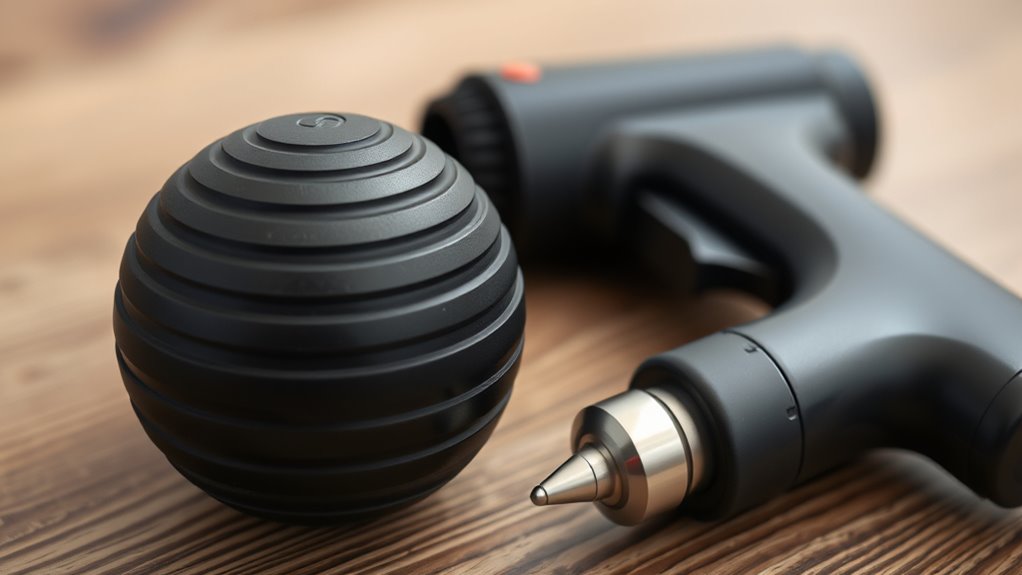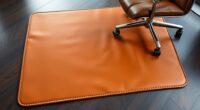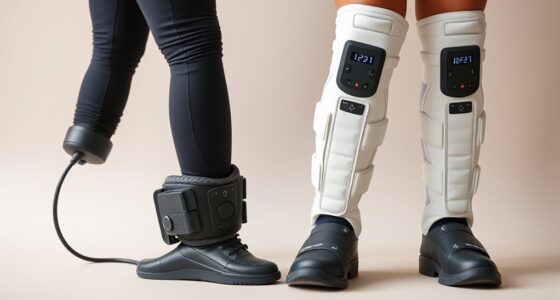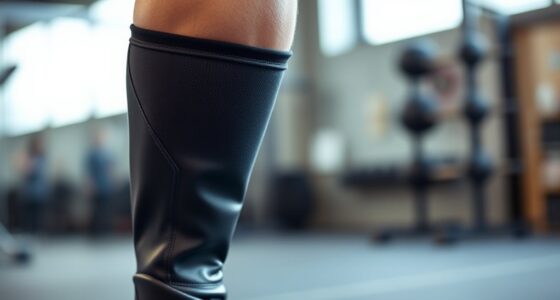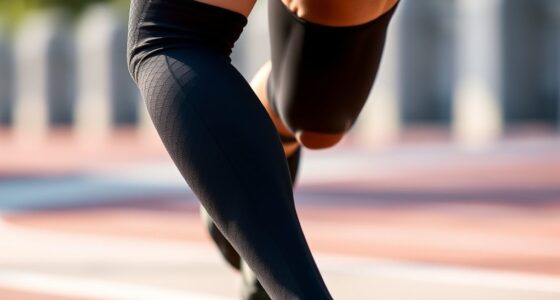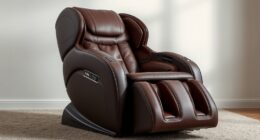Massage balls and massage guns both target trigger points to relieve muscle tension, but they serve different needs. Massage balls are portable and great for precise pressure on small, hard-to-reach spots, perfect for quick relief. Massage guns offer powerful, adjustable percussive therapy for larger muscles and deeper tissue penetration, speeding up recovery. Each tool has unique benefits, and discovering which suits your needs best can help optimize your muscle care routine—there’s more to explore if you keep going.
Key Takeaways
- Massage balls are ideal for pinpointing small trigger points and knots in localized muscle areas.
- Massage guns provide deeper, broader coverage suitable for larger muscle groups and overall recovery.
- Balls offer precise, manual pressure control, while guns feature adjustable intensity settings for varied needs.
- Use massage balls for targeted relief in small areas; use guns for efficient treatment of larger muscles.
- Both tools enhance muscle tension relief and recovery, but differ in scope and application depth.
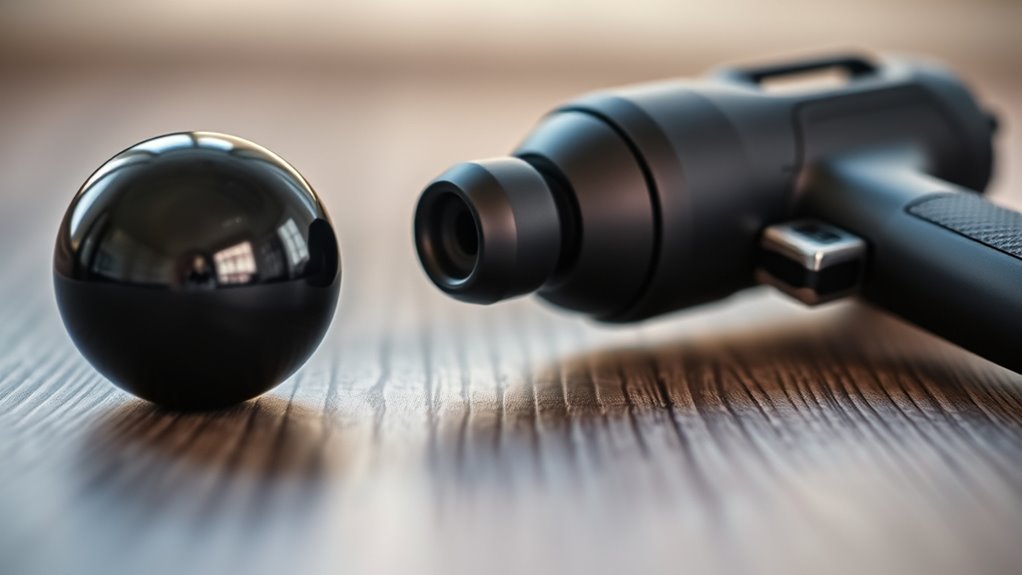
When it comes to relieving muscle tension and promoting recovery, both massage balls and massage guns offer effective solutions, but choosing the right one depends on your specific needs. If you’re exploring recovery techniques to help your muscles relax after intense workouts or long days, understanding how each tool works can make a significant difference. Massage balls are simple, portable, and versatile, making them ideal for targeting small, hard-to-reach areas. They excel at pinpointing trigger points and providing immediate muscle relaxation. Their compact size allows you to easily roll them over tight spots, knots, or sore muscles, giving you control over the pressure and focus. This makes them particularly useful for dealing with localized discomfort or for performing self-myofascial release.
Massage balls are portable, versatile tools ideal for targeting small, hard-to-reach muscle areas and trigger points.
On the other hand, massage guns are more powerful devices designed for rapid, percussive therapy. They deliver high-frequency pulses that penetrate deeper into muscle tissue, making them suitable for larger muscle groups like quads, hamstrings, or back muscles. If your goal is to accelerate recovery techniques and reduce muscle soreness after heavy training sessions, a massage gun can be a game-changer. The rapid tapping action helps break up lactic acid buildup and increases blood flow, speeding up the healing process. For muscle relaxation, especially after intense activity, massage guns can provide a more extensive treatment, reaching into layers of muscle tissue that might be difficult to target with a ball.
Your choice depends on how targeted you want your relief to be and how much pressure you need. A massage ball gives you precision, perfect for easing tight knots or trigger points in small areas, especially around shoulders, feet, or forearms. They’re also lightweight and inexpensive, making them accessible for daily use. Meanwhile, massage guns are better suited for larger muscle groups and for those who prefer a more dynamic, hands-free option. They often come with adjustable intensity settings, allowing you to customize your recovery techniques based on your comfort level.
Ultimately, both tools can be valuable parts of your recovery routine. If you want quick, localized muscle relaxation, a massage ball is an excellent choice. If you’re looking to accelerate recovery and cover broader areas with less effort, a massage gun provides powerful percussive therapy. Either way, incorporating these trigger-point tools into your regimen can help you manage muscle tension more effectively, ensuring you feel better and perform at your best.
Frequently Asked Questions
Can I Use Both Tools Together for Better Results?
Yes, you can use both tools together for better results through combination therapy and dual application. Alternating between the massage ball and gun allows you to target different muscle layers and trigger points more effectively. This approach helps reduce tension, improve circulation, and enhance recovery. Just be sure to listen to your body and avoid overdoing it. Using both tools together maximizes benefits and speeds up relief.
Which Tool Is Better for Athletes’ Recovery?
You should consider a massage gun for athletes’ recovery because it effectively reduces muscle tension and boosts blood circulation, speeding up healing. Its deep, percussive action targets larger muscle groups quickly. A massage ball works well for pinpointing smaller, stubborn knots and relieving localized tension. Combining both tools maximizes recovery, helping you stay flexible and ready for your next workout.
Are There Any Safety Concerns With Massage Guns?
Think of a massage gun as a powerful storm—you need to respect its force. Safety precautions are essential to avoid injury risks, like using the right attachment and avoiding sensitive areas. Overuse or applying too much pressure can cause bruising or nerve irritation. Always follow the manufacturer’s guidelines, stay aware of your body’s signals, and consult a professional if you’re unsure. Respect its strength to enjoy safe, effective relief.
How Long Should I Use Each Tool on One Spot?
You should generally use each tool on one spot for about 30 seconds to 2 minutes, following the duration guidelines for safety and effectiveness. For massage balls, apply gentle pressure and move slowly with your application techniques, ensuring you don’t overdo it. With massage guns, start with shorter sessions and gradually increase, focusing on the area without applying excessive force. Always listen to your body and stop if you feel pain.
Can These Tools Help With Chronic Muscle Pain?
Yes, these tools can help with chronic muscle pain by reducing muscle tension and promoting pain relief. Using a massage ball or gun regularly targets tight spots, loosens knots, and enhances blood flow. You should focus on affected areas for about 30 seconds to a few minutes each, depending on your comfort. Consistent use can improve flexibility and decrease discomfort over time, making these tools effective for managing chronic muscle issues.
Conclusion
Choosing between a massage ball and a massage gun depends on your needs, but don’t worry—both tools can effectively target muscle knots and relieve tension. If you think a massage gun might feel too intense, start with the gentler massage ball; you can always upgrade later. The key is consistency. So, pick the one that fits your comfort level and stick with it—your muscles will thank you for it!
